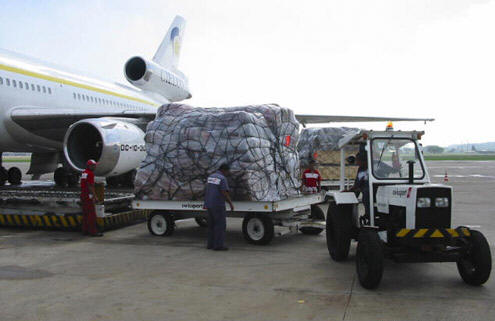
NEWSROOM
 |
NEWSROOM |
|
|
|
|
|||
|
IATA Reported
Air Passenger And Cargo Up
By Bill Goldston |
||||
 |
Demand for
international cargo rose to 0.5% below previous year levels. This is
significantly better than the 5.4% decline recorded in September. Load
factors for passenger and cargo continue at pre-recession levels of
78.0% and 54.1% respectively.
|
|||
|
Cargo capacity adjustments have come with many freighters being put into
storage or retired, resulting in a fleet reduction of 4.9%. In contrast,
the passenger fleet continues to expand by 1.8% as new deliveries more
than offset those being stored or retired. Aircraft utilization for both
wide and narrow-body aircraft is now 6% below early 2008 levels. This
low asset utilization is increasing operating costs.
Yields remain under severe pressure. Although there has been a modest
rise in air fares since mid-year, it remains around 20% less expensive
to fly in real terms today than it was a year ago.
International
Scheduled Passenger Demand
Passenger demand is now 6% better than the low point reached in March
2009, but 5% below the peak recorded in early 2008.
Compared to September, seasonally adjusted passenger volumes rose by
0.8%. Carriers in all regions except the Asia-Pacific, Middle East and
Asia-Pacific carriers saw demand grow 0.9%, lower than the 2.1% recorded
in September. The carriers
in this region, together with the European carriers, have seen demand
rise the most from their low points.
|
||||
|
While European carriers saw a demand decline of 3% in October, it is an
improvement from the -4.2% in September.
European carriers demand is still below the levels from last year
due to weakness across the Atlantic and within
North American carriers saw significant growth in international traffic
through the middle of 2009. Very significant capacity cuts across both
the
Middle Eastern carriers saw demand grow 14.3% (compared to 18.2% in
September), the highest among the regions.
The region’s carriers continue to add capacity, increasing 15.3%
in October and outpacing the growth in demand.
Latin American carriers saw significant increases in the demand for air
travel, growing 9% compared to 3.4% in September. The region’s carriers
continue to add capacity, growing 3.7% compared to 2008
African carriers
saw the demand decline 2.6% in October, an improvement from September’s
-4.2%.
International
Scheduled Cargo Demand
Cargo traffic is 14% above the December 2008 low point, but remains 15%
below the early 2008 peak.
Compared to September 2009, seasonally adjusted cargo volumes rose by
2.5%. Carriers in all regions experienced improved demand conditions in
October compared to September.
European carriers saw the biggest weakness in demand with a fall of
11.3% compared to October 2008 - relatively unchanged from the 13% drop
in September. The region’s carriers were also the most aggressive in
adjusting capacity with a 12.4% cut compared to previous year levels.
Middle Eastern carriers saw demand growth of 18.4%. This is
significantly better than the 3.6% growth experienced in September and
outpaced a capacity increase of 11.2%.
North American carriers saw a 0.5% growth in demand against a 12% fall
in capacity.
Latin American carriers recorded a 6.7% growth, significantly higher
than the 1.8% in September.
Carriers in Asia-Pacific saw demand grow 1.9% compared to -3.1% in
September. The region’s
carriers have benefited from the air freight generated by the earlier
and stronger economic revival in the region, with industrial production
now rising strongly in a number of economies.
African carriers saw demand decline 3.8%, an improvement from the -6.9%
in September.
“This recession is re-emphasizing a structural weakness in the industry.
The inability to merge across political borders has created a
hyper-fragmented industry. The industry is financially sick, and the
medicine of cross-border consolidation is off limits due to an archaic
regulatory structure. Market forces should guide our commercial
operations. Instead the bilateral system, established in the 1940’s,
puts governments in control of which markets can be served and limits
access to global capital with ownership restrictions. No other industry
faces such regulatory manacles,” said Bisignani.
Earlier this month,
“Managing through this crisis will require all commercial tools that
every other industry takes for granted.
The principles have been developed by governments covering 60% of global aviation. Now the challenge is two-fold. States that signed need to apply the principles themselves while bringing more states on board. The statement of policy principles is not a panacea, but it is a historic step in the right direction at a critical time. A financially sustainable aviation industry is a necessary catalyst for the global economy,” said Bisignani. |
| ©AvStop Online Magazine Contact Us Return To News |